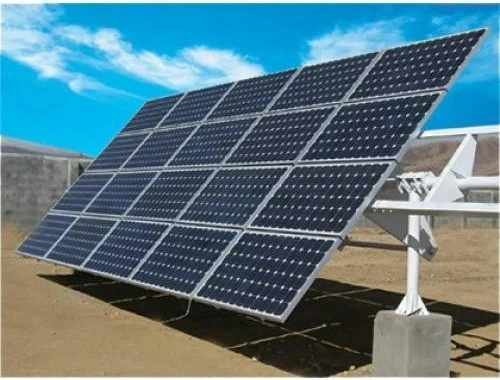An *off-grid solar power plant, also known as a **standalone solar system*, is a solar energy system that operates independently of the utility grid. It is designed to generate and store electricity for use in remote areas or locations where grid connectivity is unavailable or unreliable. Below are the complete details of an off-grid solar power plant:
Components of an Off-Grid Solar Power Plant
1. Solar
Panels (Photovoltaic Modules):
- Convert sunlight into direct current (DC)
electricity.
- Available in monocrystalline,
polycrystalline, or thin-film variants.
- Efficiency ranges from 15% to 22%.
2. Battery
Bank:
- Stores excess electricity generated during
the day for use at night or during cloudy days.
- Common types include lead-acid,
lithium-ion, and saltwater batteries.
3. Charge
Controller:
- Regulates the flow of electricity from the
solar panels to the battery bank.
- Prevents overcharging and extends battery
life.
- Types include PWM (Pulse Width Modulation)
and MPPT (Maximum Power Point Tracking).
4. Inverter:
- Converts DC electricity from the solar
panels and batteries into alternating current (AC) electricity.
- Required to power AC appliances.
5. Mounting Structure:
- Supports the solar panels and positions
them at an optimal angle to maximize sunlight exposure.
- Made of galvanized steel or aluminum to
withstand outdoor conditions.
6. AC/DC
Cables and Connectors:
- Connect the solar panels, charge
controller, battery bank, and inverter.
- Ensure efficient transmission of
electricity.
7. Backup
Generator (Optional):
- Provides additional power during extended
periods of low sunlight or high energy demand.
- Typically runs on diesel, gasoline, or
propane.
8. Monitoring System:
- Tracks the performance of the solar plant
in real-time.
- Includes sensors, meters, and software for
data analysis.
Working Principle
1. Solar
panels absorb sunlight and generate DC electricity.
2. The
charge controller regulates the electricity flow to the battery bank for
storage.
3. The
inverter converts DC electricity from the batteries into AC electricity for use
in appliances.
4. Excess
electricity generated during the day is stored in the battery bank for use at
night or during cloudy days.
Additional information
Advantages
of Off-Grid Solar Power Plants
1. Energy
Independence: Operates independently of the utility grid.
2. Reliable Power Supply: Provides electricity in remote or off-grid locations.
3. Environmentally Friendly: Generates clean, renewable energy.
4. No
Electricity Bills: Eliminates dependency on grid electricity and reduces costs
over time.
5. Scalable: Can be expanded to meet growing energy needs.
Disadvantages
1. High
Initial Cost: Requires batteries and other components, increasing upfront
costs.
2. Battery
Maintenance: Batteries need regular maintenance and replacement every 5-10
years.
3. Limited
Power Supply: Energy availability depends on sunlight and battery capacity.
4. Complex
Installation: Requires careful design and installation to ensure optimal
performance.
Applications
- Remote
homes and cabins
- Rural
electrification projects
-
Telecommunications towers
-
Agricultural operations (e.g., irrigation pumps)
- Emergency
backup power systems
Cost
and Payback Period
- Cost: Approximately 55,000 to 90,000 per kW (varies by location, system size, and
battery type).
- *Payback
Period:* Typically 7 to 10 years, depending on electricity rates and usage.
Installation Process
1. Site
Assessment: Evaluate energy needs, sunlight availability, and installation
space.
2. Design
and Planning:* Determine the optimal system size and component configuration.
3. Mounting Structure Installation: Secure the mounting structures for the solar
panels.
4. Panel
Installation: Mount the solar panels on the structures.
5. Battery
Bank Setup: Install and connect the batteries.
6 Electrical Connections: Connect the panels, charge controller, battery bank,
and inverter.
7. Testing
and Commissioning:* Ensure the system is functioning correctly.
Battery Types
1. Lead-Acid Batteries:
- Affordable but have a shorter lifespan
(5-7 years).
- Require regular maintenance.
2. Lithium-Ion Batteries:
- More expensive but have a longer lifespan
(10-15 years).
- Lightweight and maintenance-free.
3. Saltwater Batteries:
- Environmentally friendly and recyclable.
- Moderate lifespan (8-10 years).
Government Incentives
Many
countries offer subsidiesor incentives for off-grid solar systems, especially
in rural or remote areas. For example:
- In India,
the Ministry of New and Renewable Energy (MNRE) provides subsidies for off-grid
solar projects.
- In the
U.S., the federal Investment Tax Credit (ITC) offers a 30% tax credit for solar
installations.
Environmental Considerations
1. Battery
Disposal: Proper recycling of batteries is essential to minimize environmental
impact.
2. Land
Use: Ground-mounted systems should be installed on non-arable land to avoid
disrupting ecosystems.
3. Carbon
Footprint: Off-grid solar systems significantly reduce reliance on fossil
fuels.



.webp)

